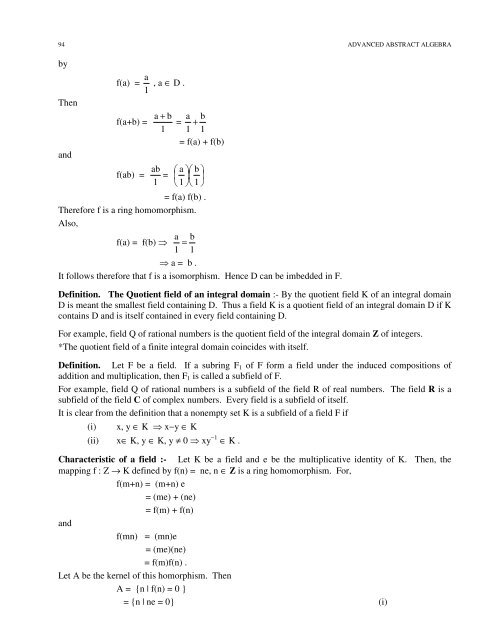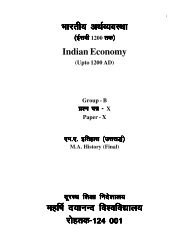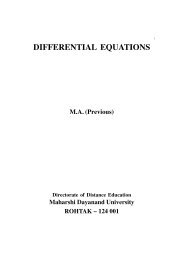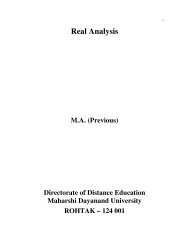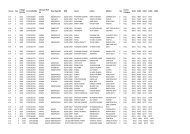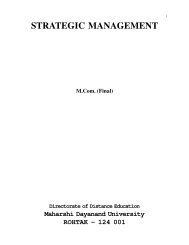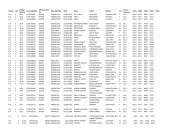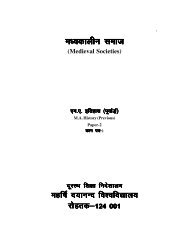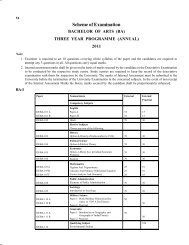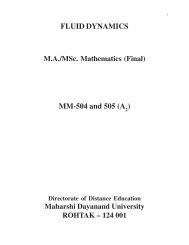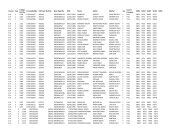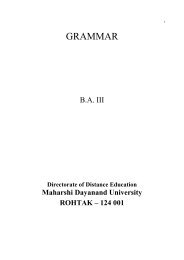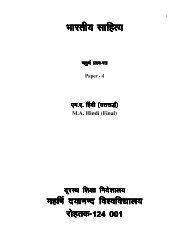Advanced Abstract Algebra - Maharshi Dayanand University, Rohtak
Advanced Abstract Algebra - Maharshi Dayanand University, Rohtak
Advanced Abstract Algebra - Maharshi Dayanand University, Rohtak
You also want an ePaper? Increase the reach of your titles
YUMPU automatically turns print PDFs into web optimized ePapers that Google loves.
94<br />
ADVANCED ABSTRACT ALGEBRA<br />
by<br />
Then<br />
and<br />
f(a) = 1<br />
a , a ∈ D .<br />
f(a+b) =<br />
f(ab) =<br />
a + b<br />
1<br />
ab =<br />
1<br />
a b<br />
= +<br />
1 1<br />
= f(a) + f(b)<br />
a <br />
b <br />
<br />
<br />
1 <br />
1<br />
= f(a) f(b) .<br />
Therefore f is a ring homomorphism.<br />
Also,<br />
a b<br />
f(a) = f(b) =<br />
1 1<br />
a = b .<br />
It follows therefore that f is a isomorphism. Hence D can be imbedded in F.<br />
Definition. The Quotient field of an integral domain :- By the quotient field K of an integral domain<br />
D is meant the smallest field containing D. Thus a field K is a quotient field of an integral domain D if K<br />
contains D and is itself contained in every field containing D.<br />
For example, field Q of rational numbers is the quotient field of the integral domain Z of integers.<br />
*The quotient field of a finite integral domain coincides with itself.<br />
Definition. Let F be a field. If a subring F 1 of F form a field under the induced compositions of<br />
addition and multiplication, then F 1 is called a subfield of F.<br />
For example, field Q of rational numbers is a subfield of the field R of real numbers. The field R is a<br />
subfield of the field C of complex numbers. Every field is a subfield of itself.<br />
It is clear from the definition that a nonempty set K is a subfield of a field F if<br />
(i)<br />
x, y ∈ K x−y ∈ K<br />
(ii) x∈ K, y ∈ K, y ≠ 0 xy −1 ∈ K .<br />
Characteristic of a field :- Let K be a field and e be the multiplicative identity of K. Then, the<br />
mapping f : Z → K defined by f(n) = ne, n ∈ Z is a ring homomorphism. For,<br />
f(m+n) = (m+n) e<br />
= (me) + (ne)<br />
= f(m) + f(n)<br />
and<br />
f(mn) = (mn)e<br />
= (me)(ne)<br />
= f(m)f(n) .<br />
Let A be the kernel of this homorphism. Then<br />
A = {n | f(n) = 0 }<br />
= {n | ne = 0} (i)


